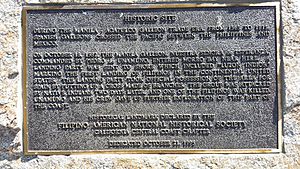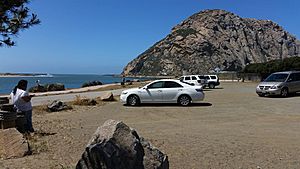Landing of the first Filipinos facts for kids
Quick facts for kids Landing of the first Filipinos |
|
|---|---|

Plaque dedicated in 1995
|
|
| Location | Morro Bay |
| Built | 1995 |
| Lua error in Module:Location_map at line 420: attempt to index field 'wikibase' (a nil value). | |
On 18 October 1587, the first Filipinos landed in what is now the Continental United States. This historic event happened at Morro Bay. They arrived on a ship called the Nuestra Señora de Buena Esperanza. This ship had sailed all the way from Portuguese Macau as part of the Manila galleon trade route.
For about three days, the ship's crew explored the area around Morro Bay. They met the Chumash people, who lived there. Sadly, during these interactions, two crew members died: one Spaniard and one Filipino. After these events, the Nuestra Señora de Buena Esperanza left Morro Bay. It eventually reached its planned destination, Acapulco, in Mexico. No other Filipinos landed in California until 1595.
In 1995, a special monument was placed at Morro Bay. It remembers the events of 1587. Since 2009, October has been named Filipino American History Month. This honors the landing and the history of Filipinos in America.
Why Did They Land Here?
Thousands of years before Europeans arrived, the Chumash people lived in this area. Their lands stretched from San Luis Obispo to Malibu. European explorers began sailing the Pacific Ocean in the early 1500s. Spain was a big part of this exploration. Vasco Núñez de Balboa was the first European to see the Pacific from Panama. Later, Ferdinand Magellan crossed the Pacific and reached the Philippines.
The Chumash first met Europeans on 10 October 1542. This was when Juan Rodríguez Cabrillo's ships sailed into their territory. Their next meeting with Europeans would be 45 years later.
Spain began to conquer the Philippine Islands in the mid-1500s. This was led by Miguel López de Legazpi. After Spain took control of the Philippines, the Manila galleon trade started in 1565. These ships sailed from Acapulco to Manila. Many of the crew members on these ships were Filipinos. They faced very tough conditions. They had poor food, diseases, and the lowest pay.
A navigator named Francisco Gali sailed the Manila galleon route. He sailed from 1582 until his death in 1586. On a trip back to Mexico in 1584, Gali sailed his ship far north. This brought the ship along the North American coast. In 1585, Gali was given a mission. He was asked to explore the Californian coast. He was also told to avoid China.
Gali died in Manila later that year. His mission was then given to Pedro de Unamuno. Unamuno had sailed with Gali from Acapulco. He had also been paid by merchants to buy goods in China. When he reached Macao, Portuguese officials took his two ships. This left him and his crew stuck in China. The Real Audiencia of Manila wanted to arrest Unamuno. He had disobeyed orders to avoid China. Luckily for Unamuno, some Franciscans wanted to return to Mexico. They helped buy a new ship, a small fragata. This ship was named the Nuestra Señora de Buena Esperanza. One of the Franciscans was Martín Ignacio de Loyola. A Japanese boy also joined the journey.
The Nuestra Señora de Buena Esperanza left the Far East in mid-July 1587. It sailed east across the Pacific Ocean. The trip was mostly calm. In early September, the ship's masts cracked. More than a month later, the ship saw land through a fog. They also saw fires on the shore. They explored and found Morro Bay. It had resources to resupply the ship. There were also trees that could be used to fix the masts. When people were seen on a hill watching their ship, they decided to send a landing party ashore. They wanted to claim the bay.
The Landing at Morro Bay
On 18 October, the ship's crew landed. This day was the feast day of San Lucas. One group included Unamuno and twelve soldiers. Another group had "Luzon Indians" (Filipinos) and a priest. The priest was Father Martín Ignacio de Loyola. Two Filipinos went ahead of the groups. They were scouting for the local people seen from the ship.
At first, they could not make contact with the local people. A group of nine Native Americans was seen, but they ran away. The landing party then claimed the land. They placed a cross on top of a hill to show their claim. After this, the landing party went back to the ship.
The next day, they landed again to explore and gather supplies. The landing party stayed ashore overnight. The next morning, 23 Native Americans approached part of the landing party. They took clothing and water bottles. Soon after, an attempt to capture Father Loyola was stopped when a gun was fired. Then, as the landing party returned to their ship, they were attacked. One Spaniard and one Filipino died from javelin wounds. Several others were injured. More crew members from the ship came to help. They fought off the attack. The next day, 21 October, the ship left Morro Bay. It continued its journey to Acapulco.
What Happened Next?

After leaving Morro Bay, the Nuestra Señora de Buena Esperanza sailed south. It was a few days behind another ship, the Santa Ana. The Santa Ana was captured by a privateer named Thomas Cavendish. Luckily, the Nuestra Señora de Buena Esperanza avoided this fate. Sailing south along the coast was hard because of bad weather and fog. More than a month after leaving Morro Bay, the ship arrived at Acapulco.
After the conflict at Morro Bay, Spanish authorities did not allow inland expeditions. The Nuestra Señora de Buena Esperanza continued to be used in the Manila galleon trade. However, it was lost off the coast of Negros Island in 1647.
The next time Filipinos landed in California was in November 1595. The Manila galleon San Agustin was wrecked at Point Reyes. This was the first European ship to be wrecked on the California coast. Unlike the events at Morro Bay, the meeting between the San Agustin crew and the Coast Miwok people did not result in any deaths. After the San Agustin wreck, the crew left in a small boat they saved. They eventually reached Acapulco.
The Chumash people had a large population even as late as the Portolà expedition in 1769–1770. However, by the 1910 United States Census, fewer than one hundred remained. One reason for this was the spread of diseases from the Old World, like smallpox.
The discovery of "Puerto San Lucas" by the galleon's crew was written in the ship's log. But this discovery was forgotten for a long time. In 1929, the log was translated into English and published. Before this, people thought Unamuno had sailed into Monterey Bay. Some thought it was Cape Mendocino or San Francisco Bay. More recently, the exact landing spot has been debated. This is because old navigation tools were not perfect.
The 1587 event is the first time Asians are known to have landed in what is now California. It's also the first time in the United States, North America, or the Americas. The landing of the first Filipinos at Morro Bay happened 33 years before the events at Plymouth Rock. This important event is often overlooked, even by Filipino Americans. For example, the Filipinos who landed in 1587 have sometimes been called "invading troops." More attention is often given to Filipino immigration to the United States during and after the American period.
Even though the landing was a big moment, Filipinos did not start settling in what would become the United States until the late 1700s. In 1992, the Filipino American National Historical Society (FANHS) began working to remember the landing. On 21 October 1995, a monument was placed at Coleman Park in Morro Bay. The mayor of Morro Bay was there. By 2009, after more efforts by FANHS, Filipino American History Month was recognized. California and the national government passed resolutions to recognize it. It happens every October to remember the landing at Morro Bay.
Images for kids
-
Looking roughly westward, the foreground has the back of the FANHS historic landmark, with Morro Rock in the background. Located in Coleman Park, on the north part of Morro Bay.



